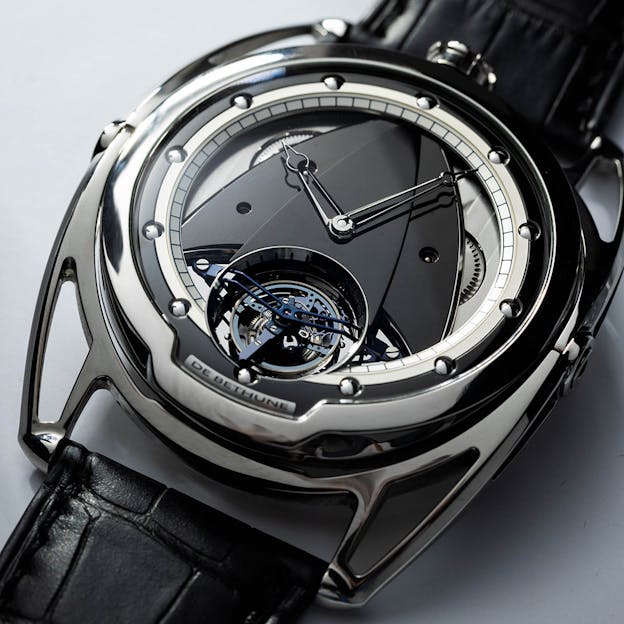Taking Sides: The Tourbillon Is A Complication
“When I use a word, it means exactly what I tell it to mean.” Humpty Dumpty, Alice In Wonderland
In this first installment of Taking Sides, Jack Forster and Griffin Bartsch debate the classification of the tourbillon and whether it should be considered a complication. Today, Jack argues that the tourbillon is indeed a complication. You can read Griffin’s counterargument here.
The question of whether or not a tourbillon is a complication, is an interesting one, especially if you like strong disagreements with extremely low practical stakes. Why anyone would argue about whether or not a tourbillon is or is not a complication, has very little relevance to … well, anything, really, except in the unusual and highly specific instance in which you are trying to determine how many complications a watch has (either for rhetorical purposes or, if you are a brand, the purpose of claiming you have set a new record for most complicated watch, which is not a situation that arises very often). Still, like the debate over date windows (and especially, 4:00 date windows) it is a subject which remains endlessly fun to debate, especially since a definitive answer to the question is, as we shall see, somewhat elusive.
Definitions That Aren’t
First of all, of course, to decide whether or not a tourbillon is a complication, one must define the term (complication, not tourbillon). What exactly is a complication? There are few if any definitive resources especially in English, on what a complication is in watchmaking. One presumably definitive source, you might think, would be the Illustrated Professional Dictionary Of Horology, however we immediately run into a frustratingly circular statement; the Dictionary defines “complication” as “the state of being complicated” which is of course no help at all (the Dictionary has a menacing affinity for circularity in general, it seems; it defines an extra-flat watch as one which is “extremely flat,” and I hope I may presume to say on behalf of all of us, Thank You Captain Obvious.
In search of something more helpful than that (which let’s be frank, is not setting the bar very high) I turn to the Fondation de la Haute Horlogerie, which from its demesne in Geneva on the aptly named Pont de la Machine, may be presumed to have both the physical and historical perspective to offer a clear answer to this conundrum. Unfortunately, we are not much better off as the FHH expanded definition equivocates rather than taking a clear position, saying in part that, ” … the tourbillon and the self-winding system are considered to be complications even though they do not fall within the generic definition.” As someone who has a long history of using the passive voice to evade personal responsibility, I can only sympathize, but of course this does not settle the real issue, which is who is doing the considering and by what right they may be doing it.
Complication Or Regulating Device?
What I have always heard (and I honestly I cannot remember from whom – probably another retro-grouch, back when I was in my young and formative proto-retro-grouch years) is that a complication more specifically is anything that offers additional information to the user. I have spent many, many years arguing for the narrower definition but I am also years weary in the battle and like a dying warrior who begins to wonder as darkness closes in, whether there might not be something to all this spirituality stuff after all, I am prepared to consider the alternative viewpoint.
The tourbillon, the argument goes, is not a complication, but a regulating device and so in principle on the same footing as a regulator index on the balance spring (which is also a regulating device). This argument probably held up better in the pre-mechanical renaissance days, when a tourbillon was a tourbillon was a tourbillon. The tourbillon made no appearance in an aperture in the dial in those long gone days of horological purity; it did not condescend to emerge in public to beguile the eye and drain the bank account.

But as Bob Dylan once sang, the times they are a changin’. The tourbillon nowadays is almost invariably exposed to view if it is present at all. Moreover there are a whole host of tourbillons which are constructed with a view to doing exactly what, historically, the tourbillon did not: delight the senses and provide diversion from the dull mendacity of daily life.
And, it is indisputably complicated, especially the multi-axis variety. Whether or not Greubel Forsey is or is not your brand of vodka, there is no doubt that in their prominence and complexity, the tourbillon(s) the company has produced over the years, are a far cry from the austere, behind-the-scenes character of the tourbillons of years gone by.

While I still hesitate to write or say it, I think there comes a time when even the most conservative, dyed-in-the-wool linguistic prescriptivist must admit that the usages of the past need not constrain the evolution of the present. This is by way of saying that when it comes to calling the tourbillon a complication, that ship has already sailed. Besides, nobody says that the minute repeater isn’t a complication and it doesn’t add any additional information either – it just (just!) tells the time acoustically rather than visually. Maybe it’s just that the number of hills I’m willing to die on have shrunk over the years, but I have to confess, I think that there is very good reason, when it comes to calling the tourbillon a complication, to bow to the inevitable progress of history and concede the point.

